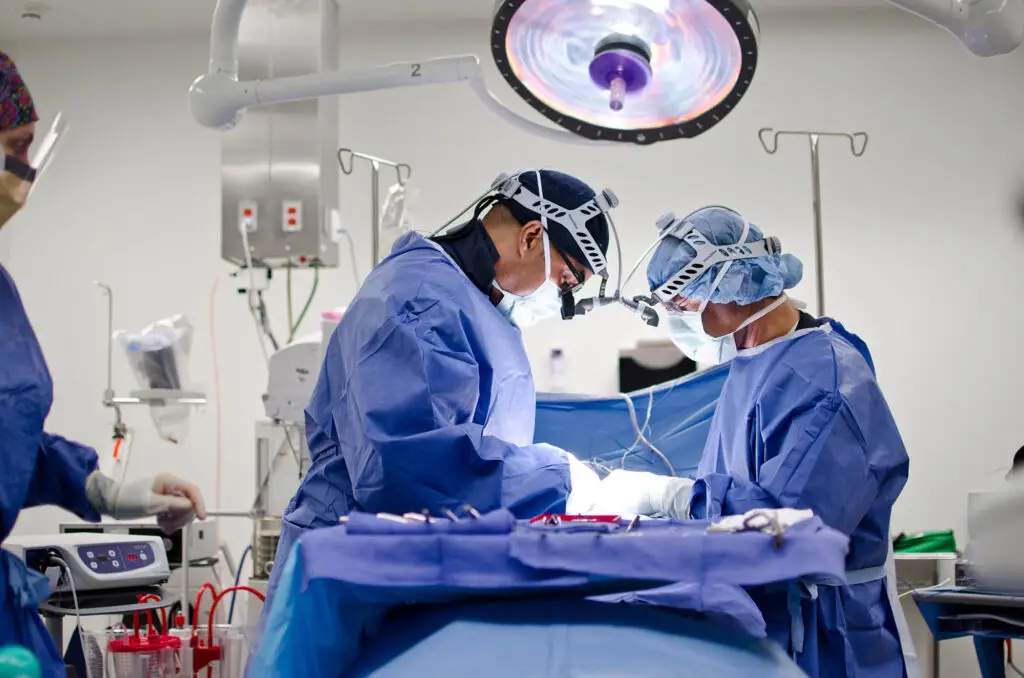“Spine Health Awareness Month” is observed every October, and each year Texas Back Institute has proudly participated in this annual event. According to the National Spine Health Foundation, the objectives of this effort are three-fold. First, it involves raising awareness about the importance of spinal health. Secondly, it seeks to educate the public about spinal conditions. And finally, it promotes preventive measures to maintain a healthy spine.
In the more than 45 years since its founding, the physicians, clinicians and staff of Texas Back Institute have participated in public health campaigns, distribution of educational materials, health screenings and wellness events, encouraged patient support groups and online forums, and reached out for media coverage and social media engagement.
This is also a good time to point out some of the most important advances in spine health over the past quarter century in which Texas Back physicians have participated.
With the world-class surgeons and technology at Texas Back Institute, it is no longer necessary to live with back pain. Contact us and set an appointment today.
#1 Artificial Disc Replacement
Working with the FDA in testing the efficacy of the procedure, Texas Back Institute was one of the pioneers in artificial disc replacement, performing the first one in March 2000 in the lumbar spine. Dr. Scott Blumenthal played an integral role in this FDA trial and has contributed extensive research and insights into artificial disc replacement.

Helping reduce the pain caused by injured or diseased discs in more than 5,000 patients has been a life-changing experience for each of these patients. Plus, these procedures and patient follow-ups have provided an extensive trove of data on the efficacy of this ground-breaking treatment. After more than 25 years, Texas Back has participated in more than 14 different FDA trials of both cervical and lumbar discs.
Speaking with eHealth Radio host Eric Michaels in a recent interview, Dr. Blumenthal was asked what inspired him to commit this level of focus and expertise to this specialized surgery.
Dr. Blumenthal responded, “It’s kind of a monumental time because we’ve just hit the 25th anniversary of the first artificial disc procedure done at Texas Back Institute as part of an FDA trial to make this technology available for patients in the US. There are two areas in the spine where discs tend to wear out, herniate, rupture, and basically degenerate. Those are in the cervical or the neck, and the lumbar, which is the low back.
“We started with the lumbar region 25 years ago and then moved to the cervical region which we’ve been doing for about 23 years. The initial couple years were all under FDA trials, but since 2004, with the FDA approval of the first lumbar disc, it’s now pretty much available for anybody who would otherwise qualify. Before this, those patients who would otherwise qualify were told by other surgeons that they were only a candidate for a fusion procedure.
“Most of those patients would, in fact, be candidates for disc replacement, and that’s how we’ve built our practice at the Center for Disc Replacement, Texas Back Institute.”
#2 The Rise of Minimally Invasive Surgery for Spine Procedures

The ability to see within the spine and address internal problems without the need for large open incisions has long been an aspiration of spine care specialists. Relatively recent technological advancements have made this dream a reality, giving rise to what is now called “ultra minimally invasive” spine surgery. This technique involves inserting a narrow camera through a tiny opening in the skin, enabling the magnification and projection of images onto a high-definition screen in the operating room.
Texas Back Institute has been one of the pioneers in this approach to spine surgery.

According to Dr. Peter Derman, a specialist in endoscopic, Ultra-Minimally Invasive Spine Surgery, “This procedure is performed via a very small, sub-centimeter incision through which a narrow camera is inserted. This minimizes disruption of the muscle and other important stabilizing structures.
“We can view the spine and surgical area on a high-definition monitor throughout the surgery. Patients often experience immediate relief of their sciatica-type symptoms and are comfortably home within hours of surgery.”
“Endoscopic surgery is an effective technique for taking pressure off nerves in the spine,” he said. “Pressure on nerves causes pain to radiate down the arms or the legs. The beauty of minimally invasive surgery is that it allows the surgeon to take pressure off nerves without doing damage to other tissues around the site of the problem.
“As has been done with knee or shoulder injuries for many years, we can now use a narrow camera to ‘scope’ the injury and correct it without opening the entire spine. Once we identify the damaged nerve and employ the scope and micro-instruments to correct it, we remove the tube, and the patient has a very small incision that is closed with a small stitch under the skin.”
#3 The Use of Robotics and 3D Printing Technology for Spine Surgery

The diagnostic and surgical technologies for treating injuries and diseases of the spine are changing and improving exponentially over a shorter and shorter time frame. The world-class spine surgeons and clinicians at Texas Back Institute have understood the benefits of harnessing the latest technology such as 3D printing, robotics and imaging tools such as magnetic resonance (MRI) and computed tomography (CT) scans and using them to formulate state-of-the-art patient treatment.
According to Texas Back Institute surgeons, Dr. Richard Guyer and Dr. Peter Derman, rapid advances in surgical technology have fundamentally improved patient outcomes. State-of-the-art technology can increase the efficiency and success of other surgical challenges such as pre-operative planning, diagnosis and the surgical procedure itself.

Dr. Guyer notes, “3D-enhanced imaging is most useful in diagnosing and treating complex deformity. It helps the surgeon understand what will be encountered in surgery.
“Due to the changes in the vertebral bodies and the connecting joints that occur when the spine begins to twist and turn in deformities, it is helpful for the surgeon to see these in a 3D printed model beforehand. With advancement in intraoperative navigation along with robotics, planning for successful correction is made easier for the surgeon.”
Dr. Derman adds, “Three-dimensional printing has been utilized in a variety of ways in the setting of spinal surgery. One use is to print 3D models of the spine before surgery so that the surgeon can manipulate and examine these before the procedure to get a better understanding of the issue. As Dr. Guyer said, this is most helpful when the spinal anatomy is particularly distorted by the issue (e.g., severe scoliosis).”
Dr. Guyer is optimistic that new technologies will continue to enhance positive patient care. “In the near future, multi-arm robotics will replace single-armed robotics in assisting the surgeon in placing hardware,” he said. “As technology advances, we will see robotic assisted decompressions which are among the most common procedures in spine surgery. Finally, navigation along with AR (augmented reality) will allow more accurate placement of implants and artificial discs in the future.”
Dr. Derman is also excited about technological advances in spine surgery. He concluded, “We are in the midst of a revolution in spine care. A variety of ‘enabling technologies’ are being used to allow us to perform spinal surgeries more safely and less invasively. These include 3D navigation, robotics, augmented reality and endoscopic spine surgery. While helpful in their current form, these technologies will continue to improve over time, becoming even more powerful.”
What Advances in Spine Care Will Occur in the Next 25 Years?

Spine Health Awareness month is a good time to think about the future of treating conditions associated with the back, neck and spine. If the past is any indication, these changes in patient care will only accelerate. No one knows when the next artificial disc replacement procedure or technology-enhanced diagnostic tool will be discovered, but there is one thing patients can count on. When it occurs, the surgeons at Texas Back Institute will be an important part of its discovery and implementation for patient care.
The constant, unrelenting back pain can ruin the quality of life for anyone experiencing it. If you are ready to be pain-free, set an appointment with an expert at Texas Back Institute.


